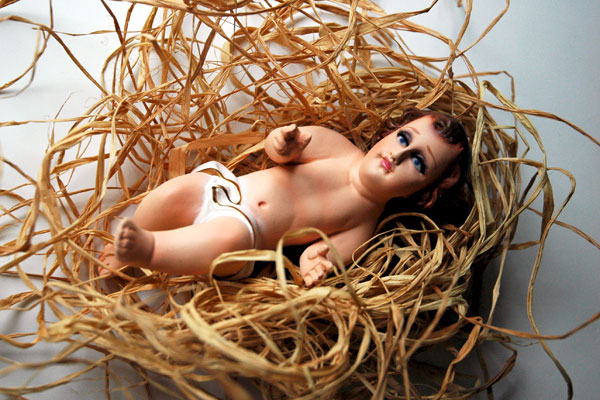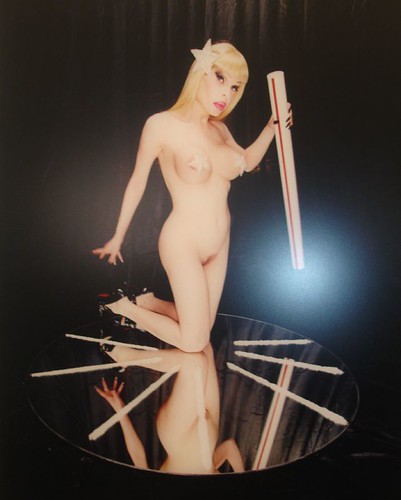A Rose Colored Ghost
La Lumiere Jaune
Chapter One -

"That's what I do is candles," she spoke loudly and clearly beneath her whitening, widening eyes, beneath her whitening, thinning hair. He gazed at her, nonplussed, barely paying attention in that way that calls attention to itself. He leaned back, his weight on one foot behind the counter, quickly sweeping the damp espresso grinds from the counter top into the aluminum knock box.
"We've got the bigger ones and - you know - the smalls and the mediums, and the Buddhists and the ones they call Juniper Joan in France. They're the ones that are yellow." She was gesturing with her hands, as if she could tease some kind of sign out of the thin air that would mean "yellow". He made another espresso, cranking the porta' to the right, stabbing the button on the left.
"Well I need candles." He said it in a tone that subtly - but unmistakeably - revealed itself to mean "You should give me some free candles."
"I can bring in the flyer. I'll bring you one." She walked out the door, into the bleak Sunday with an hysterical smile on her face, as if she'd just murdered the Easter Bunny.
"Doppio Espresso!" he called out, spinning the saucer onto the counter so that the coffee in the white demitasse cup swirled - without spilling - forming the image of Bodhi Dharma in the soft, caramel-colored crema.
Chapter Two - In the Garden

That was the morning that he had the idea for the pink.
He had painted layers of gesso on the canvas before he added the light plaster, like a layer of dust on the moon. Between each step he'd used the sandpaper, here and there, one spot rough, one spot smooth, drawing a map of the human capacity for love.
This morning he mixed the pink just as he had in his dream, the the plum color he'd already used and the white and the cadmium, and the thinner. Thinner than thin. A rose-colored ghost.
He used a roller, riding just over the edge of the tape covering nearly two thirds of the horizontal rectangle on the right side.
She came in from the street from the car from the store where she'd run to get salami, whiskey, tampons and new batteries for the camera.
"It's started," she said as if gazing at a horizon after a quick steep climb.
"Gimme." He took the sack from her arms and walked into the house, the screen door banging behind him. She looked back at the painting and smiled, her shoulders rising a bit, her beaming face bending slightly down and to the right as if she was crushing her nose against a baby.
Chapter 3 - I Want Everything
They found the Saint in the middle of the road. By then he'd gone completely blind from the corrosion of the visions and his hands had become misshapen crescents - like a crabs claws; shining, hard, and smoothed by prayer.
The End
Espresso Machine Parts Glossary & Nomenclature
(from http://www.espressoparts-usa.com/category/espressotutorials.01_espresso_glossary/)
Espresso: Nomenclature
The Oxford English dictionary is the leading authority on the etymology of the English language, and provides a clear source for English. Espresso is a purely Italian word, as the O.E.D. states:
Espresso,
[It. caff� espresso, lit. '�pressed-out coffee']
However, for a more concise understanding of where the term 'espresso' comes from, one must delve a little deeper and explore the word 'Coffee'�. Again from the O.E.D.:
Coffee,
[ad. Arab. qahwah, in Turkish pronounced kahveh, the name of the infusion or beverage; said by Arab lexicographers to have originally meant 'wine' or some kind of wine, and to be a derivative of a vb.-root qahiya 'to have no appetite'. Some have conjectured that it is a foreign, perh. African, word disguised, and have thought it connected with the name of Kaffa in the south Abyssinian highlands, where the plant appears to be native. But of this there is no evidence, and the name qahwah is not given to the berry or plant, which is called bunn, the native name in Shoa being b{umac}n.
The European langs. generally appear to have got the name from Turkish kahveh, about 1600, perh. through It. caffe cf. F., Sp., Pg. caf�, Ger. kaffee, Da., Sw. kaffe. The Eng. coffee, Du. koffie, earlier Ger. coffee, koffee, Russ. kophe, kophe{ibreve}, have o, app. representing earlier au from ahw or ahv.]
Now a clearer idea of the meaning of 'espresso' comes to the surface. We have seen that it literally means "pressed-out coffee"�. This is partly due to the process of extracting coffee from the beans in an ingenious process developed in 1901 by Luigi Bezzera. Some stories report that he wanted to be able to brew coffee faster so that his employees wouldn'�t take lengthy coffee breaks, so he came up with the idea of using steam pressure to quickly force water through coffee held in small removable baskets. It probably did not take him long to figure out that loose grounds held in this basket were not producing a very good cup, so, after re-calculating the volume of grounds and temperature of water, he pressed it and produced the first espresso.
Now on to the espresso machine parts.
Espresso Machine Parts Glossary
Portafiltro (Portafilter)
This words definition is simply based on the word split in two: porta (portable) filtro (filter). It could be said that it is the first best tool of the barista when it comes to interacting with coffee. Without it, there is no espresso. But without its best friend and next best tool, the tamper, or the thing that one presses or �tamps� the ground coffee with in the portafilter, your grounds are useless. There are literally hundreds of designs of tampers, but the best would certainly be a tamper that fits snuggly into the portafilter.
Portafilter Body
The main component of the portafilter is the 'body' of the assembly. The body holds the 'filter'�, or 'basket'�. The remaining components are the tension 'spring' which keeps the basket in place, the 'spout' which directs the flow of the espresso and the 'handle'� itself. In most cases the body of the Portafilter is specific to each manufacture, but in some cases, different manufactures have borrowed the designs from other manufactures, and they may be interchangeable from model to model.
Portafilter Spring
The springs hold the baskets in place. It is held in the portafilter by clipping in to a groove that is milled into the inner surface of the portafilter body. Some are round in profile and circumference, but most are bent into a hexagonal shape with one open end.
Portafilter Basket
The same is true with the baskets, not only in size, but also in volume. Most machines use a standardized portafilter basket with the volume capacity of 14 grams for the 'double-shot', but 12 gram versions are available for some machines. For the 'single-shot', most people are comfortable with the standard 7 gram basket, not even knowing that a 6 gram basket is available as well. Some machines portafilter bodies are able to accept an even larger size: a 'triple' or 21 gram basket. These variances are based exclusively on personal preference, and in the end will not affect the quality of a drink: in the end, it is the barista that chooses and grinds the coffee and then pulls the shot, not the basket.
Portafilter Spout(s)
The spout attached to the bottom of the body of a portafilter offers a barista yet more choices.
In most cases the portafilter spout is threaded onto the bottom of the portafilter. Most manufactures (except Gaggia, which employs a �"�) use a 3/8"� threaded fitting. The double shot versions are available tall, short, with a cover or without, in an adjustable or the standard non-adjustable style. The single shot comes with a straight, curved, short or tall choice. A rare and essentially never used triple� spout can also be used.
For the La Cimbali machines, a screw on style is used. Two screws hold a double or single spout onto the body. The height of your drain pan in relation to your cup may be a factor in choosing a style of spout. Most baristas will agree that being able to physically see a shot being poured thus being able to closely watch the process for quality is very important. Placing a large 16oz. or 20 oz. cup directly under the portafilter, pressing a button and walking away is frowned upon by any barista with distinguished taste and respect for the art.
In some cases, a machine will simply refuse to pour an even double shot from each end of the spout no matter how much �'tweaking'� of tamping or positioning a barista may try. This is what the adjustable spouts are for. The adjustable spout re-directs the espresso from one side to another with the turn of a screw. As with the baskets, one portafilter spout is not necessarily better than another, but you may find that your functionality and efficiency may be improved by your choice of spout.
Gruppo (Group Head)
The group head (brew head) is the large protrusion coming off of the front of an espresso machine which the portafilter is engaged to when brewing. Most espresso machines are categorized by the number of groups that are on the machine, i.e., one (single), two, three or four group. The group head can sometimes be an enigma to owners, users and customers alike. There are various different styles of group heads as with all other components of espresso machines.
The oldest system is the lever operated espresso machine. It uses a lever and piston assembly to force water through the grounds with a steady yet adjustable flow; the barista has the ability to increase and decrease the water dispensing pressure as he/she pulls a shot. This is where the term "�pull a shot" comes from. There are also a wide variety of hydraulic heads that are, today, rarely produced, and difficult to find parts for. These work in a similar way as the lever groups allowing the barista to control the flow rate, but use a combination of smaller vertical pistons that open and close with a small lever or arm. The most common form of group head today is the solenoid operated group. It employs and electronic coil that energizes a valve to open and close its orifice and allow water through - or keep it contained -� and are operated with either an analog rocker switch or digital electronic circuit commonly referred to as a touchpad.
Solenoid group machines are then divided into three other designations: super-automatic, automatic and semi-automatic.
Super-automatic Espresso Machines
Super-automatic machines are the newest style of espresso machine on the market. These machines grind the coffee, tamp, extract and dispose of the grounds, while frothing milk and pouring the entire drink - whatever drink one selects from its digital touch pad - all in one step.
Espresso aficionados are of the opinion that these take the heart out of brewing coffee, but they are very useful and convenient for extremely high volume, high traffic (both with customers as well as employees; little training is required) locations.
The down side is that they can be very labor intensive for technicians, if one is able to find a certified or trained technician at all, leading to costly service bills.
Automatic Espresso Machines
Automatic espresso machines are probably the most common machine on the market. The come with programmable digital touchpad dosing circuits. The operator enters two single (one short and one long) and two double shots timed shot pours into the computer in the machine. The computer then sends a signal to both the pump motor and flow meter (a small electronic wheel also called an impeller) to dispense water though the group.
Rubinetti Vapore/Acqua (Steam/water Valves)
Steam and hot water valves are no less important than the group heads; they are used just as often if not more! Most two, three and four group commercial machines only come with two steam and one hot water wand. The steam wands on most traditional commercial machines are placed at either end of the machine, and move in any direction. Some older equipment steam wands will only move forward and back, but check with a dealer of the equipment -� there may be a retro-fit kit if this design doesn'�t work for you.
In recent years, some manufactures have started producing equipment that comes out of the box with what is known as an 'auto-frother'. In days past these were an optional item. These are attachments placed on a traditional steam wand, or replacing the steam wand altogether. They allow the operator to quickly froth milk without learning or implementing the skills practiced by traditional baristi for frothing milk. Some are very technically advanced, going as far as digitally displaying the temperature of the milk, but with all of them - as with traditional wands, but to a far greater degree -� they must be cleaned daily, which can be labor intensive due to the number of components they are assembled with.
Hot water wands are kept very simple. They are normally an aerator threaded into a tube which draws hot water out of the boiler. In most cases, the machine must be hot for the siphoning effect of the valve to be operational.
Both steam and hot water valves may be operated by a knob that one turns, a lever one activates, or a button, digital or analog, that one presses. Valves that are opened via a knob are easily repairable, and are similar to the valves we see in sink and tub faucets. Lever activated valves are just as simply constructed, but can take a little finessing to repair.
Electrically opening valves all use a solenoid to open and close the valve, but digitally operated valves can be problematic. With a digital steam or water valve, a signal must first go through the circuit board behind the button before sending the signal to the solenoid to open or close. This can be a problem to diagnose: is it the circuit that has failed, or the solenoid?
Caldaia (Boiler)
Boilers in espresso machines vary in construction material, size and assembly. Most are brass. Some are constructed out of stainless steel. The benefit of a stainless steel boiler is the fact that it will never rust, but by the time a brass boiler rusts out of a machine, it has probably been long enough for the machine to have already paid for itself in sales it has produced. All boilers are subject to, and victims of, lime and mineral scale build-up.
The size of a boiler can be important. With a large capacity boiler and a small wattage heating element, the machine will take longer to heat up and struggle to maintain its optimum temperature in a high volume output environment. The variables of wattage, voltage and boiler capacity are infinite and can be very confusing, but a comfortable high ratio would be about 300 watts per listed boiler liter capacity for a 220 volt machine.
The most prevalent boilers on the market use a heat exchanger to supply water to the group head(s). Heat exchangers are essentially boilers inside of a boiler. The ambient heat of the water and steam inside the main boiler heats up the cool water coming into the heat exchanger. What this means is that the temperature of the water is directly dependent on, and related to, the amount of steam pressure in the boiler. If one increases the steam pressure, they are also increasing the temperature of the water being dispensed out of the group. In two, three and four group machines, this effect takes place across the board, thus the adjustability of steam pressure and water temperature is limited.
Some machines come manufactured with two separate boilers; one for steam and one for brewing. The benefit of this is the ability to adjust either boiler to your specific needs or desires. Each boiler has a different circuit controlling its heating element, and can be dialed in for the desired temperature of brewing and steaming.
Boilers are filled with fresh water in two ways: with a manual-fill valve, and with an auto-fill valve. These two valves work in tandem. The main power switch for machines generally turns on the auto-fill circuit, allowing water to by-pass the manual fill valve through the auto-fill solenoid and fill the boiler with water. Once the water reaches a probe (the auto-fill probe) that is threaded into the top of the boiler, this grounds the circuit out, telling the solenoid to close and the pump motor to turn off. The manual-fill valve is usually only used in emergencies when one or more of the auto-fill components has failed. These valves can also be electronically opened, but most use a standard push stem valve. Additionally, the manual-fill valve differs from the auto in that it doesn'�t use the pump motor to allow water in, only the static pressure of the water supply.
Keeping a close eye on the water level is very important. An empty boiler will quickly burn out the heating element.
Pompa (Pump)
The pump is used to push water through the group head, as well as fill the boiler. Most commercial machines use a large pump called a rotary vane pump. They are commonly made of brass and come with water in and water out fittings, a mounting flange, an adjustment screw and a drive shaft. The most common version has a clamp style mounting flange and a flat drive shaft. Other variations are a bolt on flange, using two or three bolts, a retrofitted three prong flange adaptor and or a round drive shaft. These pumps should all have an adjustment screw located on the side of the pump that one uses to increase or decrease the dispensing water coming out of the group head. While dispensing water, one turns the screw clockwise to increase or counter-clockwise to decrease the pressure. All rotary vane pumps are required to be hooked up to a pressurized water supply. These pumps can only run without water for about 75 revolutions before the graphite bearings wear out and the pump is ruined.
Some smaller compact models (and almost all home machines) come with a different style pump, the vibratory pump. These are smaller, less expensive and not adjustable. Some, such as the Fluid-o-tech model, are connected to the electrical wiring via a wiring boot that snaps on and is held in place with a screw. Others, such as the Ulka model, come with two spade type terminals, that may or may not be wired in with a high limit pump shut-off diode. They do not need to be installed to pressurized water, and are not attached to a pump motor, discussed next.
Motopompa (Pump Motor)
The motors turn the pump. In most new machines, the motor and pump are placed inside the machine, but in a large majority of older machines, the pump is mounted outside. Some manufactures still prefer to keep the look of their equipment the same, and so have not modified their body assembly to be able to fit a pump inside. This is inconsequential as the pumps and motors are very durable.
As with pumps, there are different models of motors available as well. The most common is the clamp flange, flat drive shaft model. Others may have a round or splined drive shaft and holes in the flange for bolts. They are available in different sizes as well, but the important thing when replacing a motor is to get the exact wattage and voltage, as well as the same microfarad rating on its start capacitor.
That pretty much covers all of the major working systems of an espresso machine. As with any piece of machinery, all makes and models, even if they have the same tag, may not be exactly the same. So be observant, vigilant and patient when working on the equipment.
Hey! What are you doing? Take a second and find me on my Facebook. Send me a friend request on the site!
Check out my videos, the archives of The Sleepless Film Festival, and more at my new You Tube channel: Joe Nolan's Imagicon
Listen my new CD - Blue Turns Black!
Love,
Joe Nolan
Use this player to listen to my new CD. Purchase a song or two at your favorite digital outlet and help us stay awake here at Insomnia!
Check out my profile at Reverb Nation to see my updated press and bio.
Listen to my earlier releases, and enjoy free downloads here!

Labels: joe nolan, poetry, spinning back fist




































